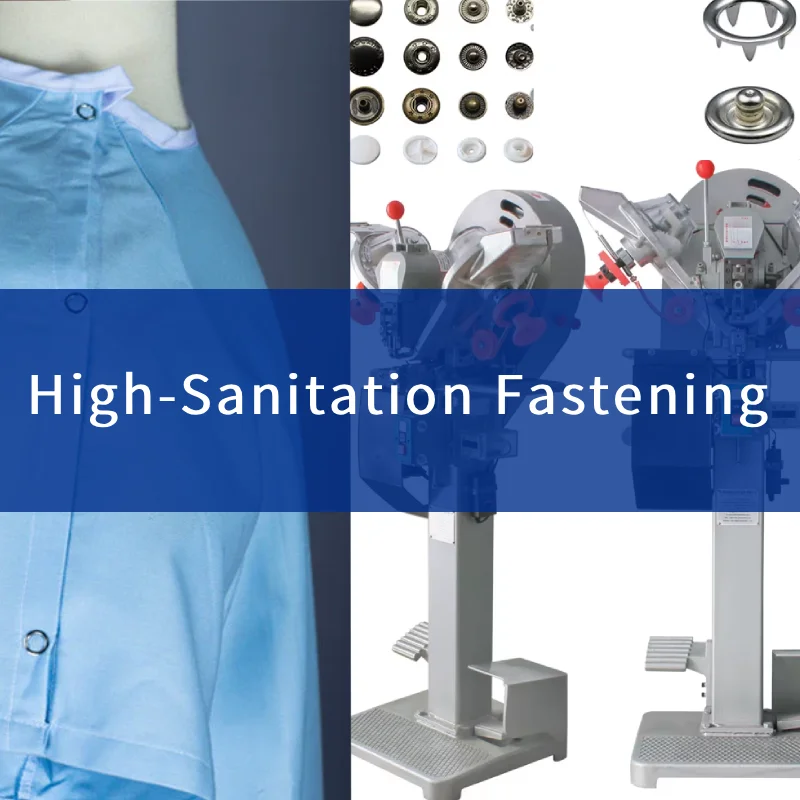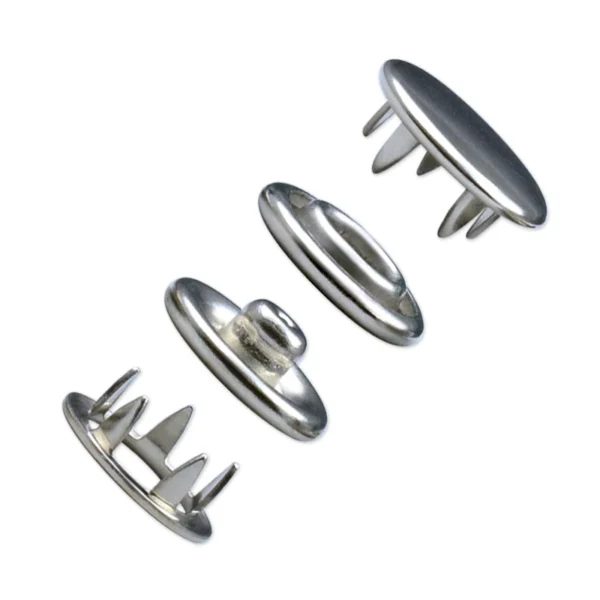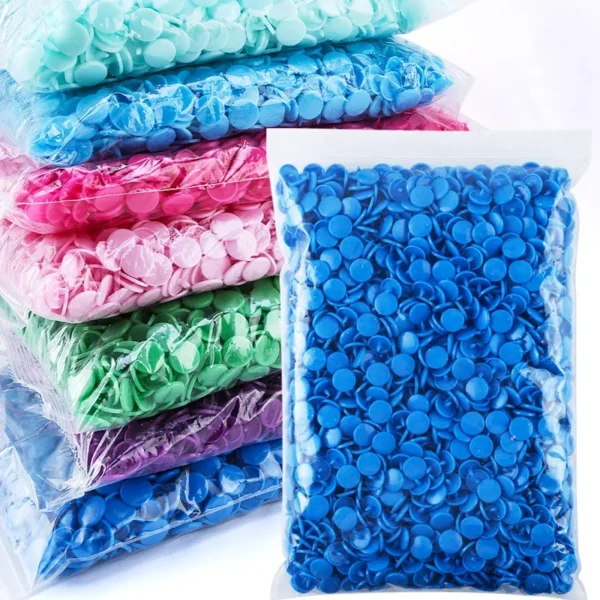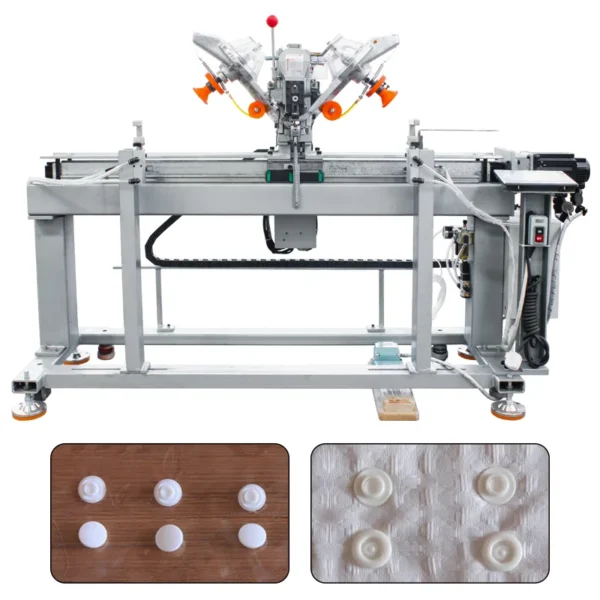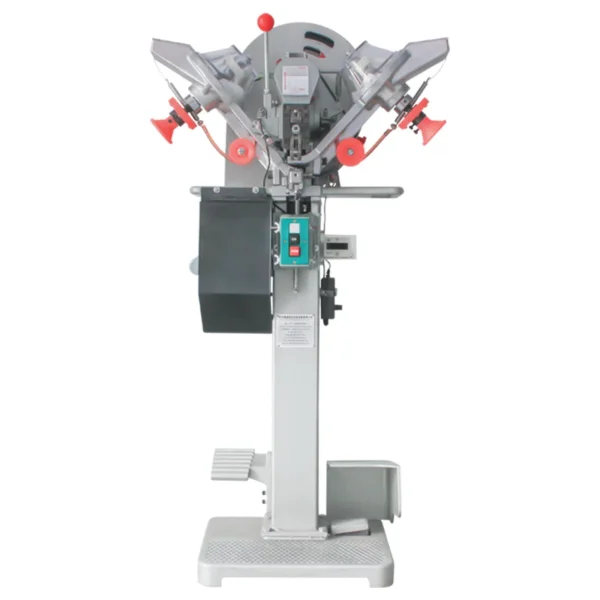When we think about medical protection, our minds go straight to masks, gloves, or gowns. But few people realize that the snap button — a small, almost invisible part of a reusable surgical gown — plays a crucial role in maintaining both functionality and hygiene. In medical environments, where safety, sanitation, and reliability are non-negotiable, even a minor fastening failure can have significant consequences.
For over a decade, our company has specialized in Automatic Snap Button Machines, and our journey into the medical textile industry was eye-opening. Hospitals and healthcare suppliers needed fastening solutions that could withstand high-temperature sterilization, harsh disinfectants, and continuous reuse — all while remaining easy for medical staff to handle quickly.
Through years of testing, collaboration, and refinement, we learned that the secret to reliability isn’t just the material of the snap button — it’s how precisely it’s applied. That’s where automation transforms everything. In this article, we’ll share not just the technology, but the insights, experiences, and lessons that come from working at the intersection of machinery, material science, and medical safety.
The Critical Role of Snap Buttons in Reusable Surgical Gowns

Reusable surgical gowns are designed for repeated laundering and sterilization cycles — often over 50 or even 100 uses. Their closures must therefore be tough, hygienic, and ergonomically designed. Traditional hook-and-loop fasteners (like Velcro) often degrade under repeated autoclaving or chlorine exposure, which is why snap buttons have become the preferred fastening method in modern reusable gowns.
Snap buttons provide a secure closure, withstand repeated washing, and maintain their mechanical strength over time. But their reliability hinges on precise installation. If applied unevenly or at inconsistent pressure, the snaps can leak, loosen, or damage the gown’s high-performance fabric — which is often made from barrier materials like polyester microfiber with polyurethane coatings.
That’s where Automatic Snap Button Machines play a pivotal role. Unlike manual or semi-automatic methods, our fully automated systems deliver consistent pressure, perfect alignment, and contamination-free application — all of which ensure that each gown meets stringent healthcare standards.
As one of our long-term partners, a medical textile supplier in Germany, once told us:
“We stopped thinking of snaps as just fasteners. In our line of work, they’re part of the gown’s protective system. Your machine made that possible.”
Challenges in Manual Snap Button Application
When we first entered the healthcare textile market, we were surprised to see how many factories still installed snaps manually — using handheld presses or foot-operated machines. While these tools had served well in garment factories, they weren’t designed for medical-grade production.
Manual methods presented several issues:
- Inconsistency: Operators applied uneven pressure, causing some snaps to deform or fail under sterilization.
- Contamination Risk: Physical handling increased the possibility of introducing contaminants during assembly.
- Operator Fatigue: Repetitive pressing movements caused strain and slowed down production.
- Quality Variability: Even small variations in depth or alignment could lead to leak points or detachment during hospital use.
In healthcare, inconsistency isn’t just inefficient — it’s dangerous. A single loose fastener can compromise a sterile barrier. We knew automation had to step in, not just for efficiency, but for patient safety.
How the Automatic Snap Button Machine Revolutionizes Gown Production
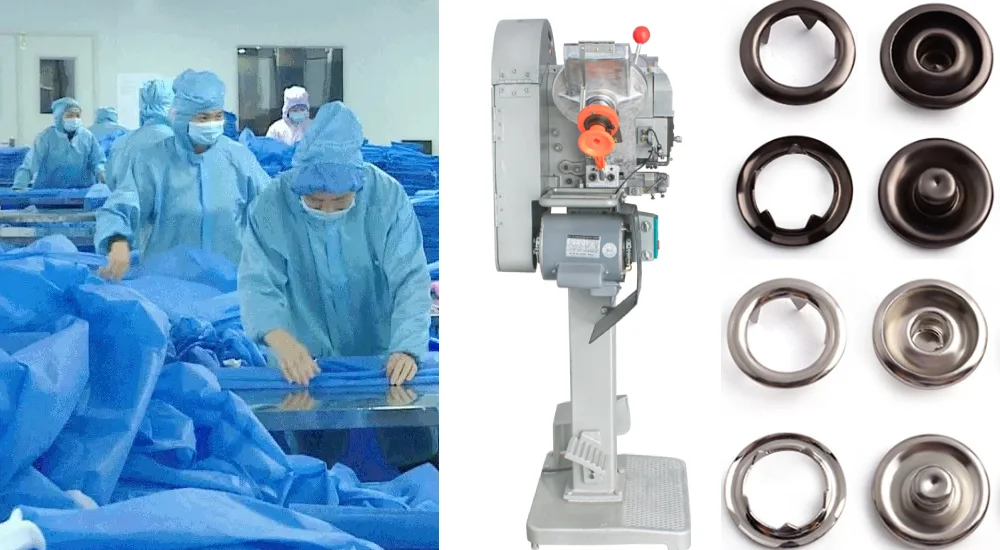
Automation brings more than speed; it brings control. Our Automatic Snap Button Machine was developed with medical textiles in mind, integrating both precision mechanics and hygiene-focused engineering.
Here’s how it works in a typical production line:
- Automatic Feeding System: Snap components are separated and oriented automatically in a sealed feeding bowl, minimizing human contact.
- Laser-Guided Positioning: The system identifies exact placement points on the gown fabric to ensure perfect alignment.
- Sterile Pressing Process: The snap is applied using controlled pneumatic or servo-driven pressure, ensuring uniform attachment.
- Real-Time Quality Check: Sensors verify every snap’s integrity — pressure, alignment, and closure performance.
- Digital Traceability: Each cycle is recorded, allowing quality assurance teams to trace production data for regulatory compliance.
The result? A perfectly installed, hygienic, and durable snap button — every single time. No contamination, no variability, no rework.
In 2022, one of our medical customers reported a 98.7% reduction in fastening-related defects after switching from manual to automated application. That’s not a statistic — that’s peace of mind.
Meeting Global Sanitation and Safety Standards
In medical textile production, compliance isn’t optional. It’s the foundation of trust.
Our machines are designed to meet international standards, including:
- ISO 13485: Quality management for medical device manufacturing.
- ISO 16603/16604: Resistance of protective clothing materials to blood-borne pathogens.
- EN 13795: Performance requirements for surgical gowns and drapes.
- AAMI PB70: U.S. standard for liquid barrier performance of protective apparel.
By ensuring uniform fastening pressure and zero-fabric tearing, our system supports the structural integrity needed to pass these stringent tests. Furthermore, every component of our machine that contacts the garment is made from stainless steel or medical-grade aluminum, resistant to corrosion and easy to sanitize.
Automation also minimizes human contact, reducing microbial exposure during production — an essential factor for maintaining medical-grade cleanliness.
Material Science: Understanding Gown Fabric and Snap Interaction
Reusable surgical gowns typically use polyester or polyamide blends coated with hydrophilic or breathable membranes. These fabrics are sensitive to pressure and heat, requiring careful handling during fastening.
Through hundreds of test cycles in our R&D center, we’ve discovered that even a 0.2 mm deviation in snap placement depth can cause premature fabric fatigue after multiple sterilization rounds. To counter this, our machines employ adaptive force sensors that adjust pressing intensity in real-time, depending on the fabric’s resistance.
This technology — which we call SmartPress Control — ensures that every snap sits firmly without compromising fabric structure. The outcome is a gown that remains functional, washable, and comfortable throughout its life cycle.
Our engineers often say, “If you want a gown to survive 100 washes, it starts with one perfect press.”
Voices from the Field: What Our Customers Say
Feedback from the field has always guided our innovation. Here are just a few testimonials from medical textile manufacturers who’ve adopted our system:
“Before automation, 15% of our gowns failed post-wash inspection due to snap detachment. After installing your machine, that number fell to zero.”
— Operations Director, Medical Garment Factory, South Korea.
“The auto-feeding system reduced our labor by half while doubling output. More importantly, our gowns now pass every AAMI test without rework.”
— Production Manager, Hospital Textile Supplier, USA.
“Your machine brought consistency we didn’t think possible. It’s not just about speed — it’s about trust in every stitch and snap.”
— Textile Engineer, Italy.
These stories remind us that automation isn’t just mechanical progress — it’s human progress. Every secure snap helps a surgeon focus on saving lives, not adjusting a gown.
Hygiene-Focused Design: Building Machines for Cleanroom Compatibility
Medical environments demand extreme cleanliness — and so should their production equipment. Our machines are built with cleanroom compatibility in mind. The enclosed snap feeding system, anti-static components, and easy-to-sanitize surfaces all contribute to a contamination-free process.
Every machine undergoes surface smoothness testing to ensure there are no micro-grooves where particles could accumulate. Optional UV sterilization modules can also be installed over the pressing area to maintain aseptic conditions during production.
The goal is simple: zero contamination from the fastening process. It’s a commitment that sets medical garment automation apart from fashion manufacturing.
Efficiency and ROI: The Economic Advantage of Automation
Hospitals are under constant pressure to control costs, and so are the manufacturers who supply them. Automation isn’t just about precision — it’s about long-term profitability.
Let’s look at real-world numbers:
| Metric | Manual Application | Automatic Machine |
|---|---|---|
| Operator Requirement | 3 workers | 1 operator |
| Output | 300 gowns/hour | 1,200 gowns/hour |
| Reject Rate | 5–8% | <0.3% |
| Payback Period | — | 9–12 months |
Beyond the financials, automation reduces physical strain on workers and minimizes the need for re-inspection. That means fewer headaches for managers and faster turnaround times for hospital orders.
Sustainability and the Future of Reusable Medical Textiles
In a world increasingly aware of medical waste, reusable gowns are a major step toward sustainability. But for them to truly replace disposables, their fastenings must last through countless sterilization cycles.
By automating snap installation, we help manufacturers ensure consistent durability — extending product life and reducing waste. Our machines also use energy-efficient pneumatic systems and low-maintenance servomotors, lowering power consumption by up to 20% compared to conventional presses.
Sustainability isn’t just about recycling materials; it’s about designing systems that make reuse viable. Automation makes that possible.
Innovation in Motion: AI Monitoring and Digital Traceability
The latest generation of our Automatic Snap Button Machines includes AI-based quality control and data tracking. Each snap application generates a unique digital record — capturing force, temperature, and alignment data. This allows full traceability, which is increasingly demanded by regulatory bodies like the FDA and EU MDR.
AI algorithms also detect abnormal patterns, such as a worn die or misaligned feeder, before they cause defects. This predictive maintenance approach keeps lines running smoothly and saves countless production hours.
We like to say: The machine learns so your team doesn’t have to relearn mistakes.
Beyond Machinery: Partnership, Training, and Long-Term Support
Our relationship with clients goes far beyond the sale. We provide on-site training, process optimization, and long-term service agreements. Our engineers work directly with medical textile producers to fine-tune pressure settings, die configurations, and workflow integration.
This partnership approach has earned us repeat customers in over 40 countries. Many of them have relied on our machines for more than a decade — a testament to reliability and trust.
In fact, one of our earliest hospital supply clients still operates their first machine, installed in 2013. “It hasn’t missed a beat,” their maintenance chief said. “It’s the one part of our line we never worry about.”
Conclusion
The snap button might be small, but in the world of reusable surgical gowns, it holds enormous responsibility. It ensures a gown stays secure, sterile, and strong — even after hundreds of washes and countless sterilization cycles.
As manufacturers of Automatic Snap Button Machines, we see ourselves as quiet partners in healthcare — empowering textile producers to build gowns that protect lives with every snap. Automation doesn’t just make production faster; it makes it safer, smarter, and more sustainable.
Because in a world where sanitation is everything, precision is the new hygiene.
FAQs
1. Can the same machine be used for different snap materials?
Yes. Our machines support stainless steel, aluminum, and medical-grade plastic snaps with quick-change molds.
2. Is the machine cleanroom-compatible?
Absolutely. All components are built for easy sterilization, and optional UV modules ensure aseptic operation.
3. How does the machine prevent contamination?
By using enclosed feeding systems, minimal human contact, and hygienic-grade materials.
4. What standards does the machine comply with?
ISO 13485, EN 13795, AAMI PB70, and CE safety certifications.
5. How long is the payback period for hospitals or suppliers?
Typically 9–12 months, depending on production volume.
6. Can it handle both plastic and metal snaps?
Yes, the pressure and die setup can be adjusted for either material type.

